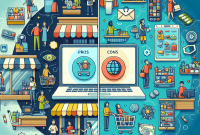
The Rise of E-commerce: How Online Shopping is Reshaping Retail
With the rapid advancement of technology and the convenience it provides, e-commerce has quickly become a dominant force in the retail industry. The rise of online shopping has transformed the way consumers browse, compare, and purchase products, as well as the way businesses operate and market their goods. This article explores the impact of e-commerce on traditional retail, delving into the opportunities and challenges it presents for both consumers and businesses.
The Evolution of E-commerce
Before diving into the current state of e-commerce, it’s essential to understand its evolution. The concept of buying and selling goods online first emerged in the 1990s, and it has since grown exponentially. E-commerce has evolved from simple online transactions to sophisticated platforms that allow for personalized shopping experiences, advanced payment methods, and streamlined logistics. With the advent of smartphones and other connected devices, consumers can now shop from anywhere, at any time, with just a few taps or clicks.
The Impact on Brick-and-Mortar Retail
The rise of e-commerce has had a significant impact on traditional brick-and-mortar retail. Many physical stores have struggled to compete with the convenience and accessibility of online shopping, leading to closures and a shift in consumer behavior. However, some retailers have embraced e-commerce by integrating online and offline experiences, offering click-and-collect services, and creating immersive in-store experiences to attract customers. This shift has forced brick-and-mortar retail to adapt and innovate to remain relevant in a digital world.
Changing Consumer Behavior
E-commerce has fundamentally changed consumer behavior, influencing how people discover, research, and purchase products. With a wealth of information at their fingertips, consumers can easily compare prices, read reviews, and seek out the best deals without leaving their homes. This has led to increased price competition and heightened consumer expectations for convenience, speed, and personalized service. Additionally, the rise of social media and influencer marketing has further shaped consumer preferences, driving demand for unique and exclusive products.
The Role of Technology and Innovation
Technology and innovation have been driving forces behind the growth of e-commerce. From artificial intelligence and machine learning to augmented reality and virtual reality, retailers are constantly exploring new ways to enhance the online shopping experience. These advancements have led to more personalized recommendations, interactive product visualization, and seamless checkout processes. Moreover, the use of data analytics and customer insights has allowed businesses to understand and respond to consumer needs more effectively.
The Global Impact of E-commerce
The rise of e-commerce has transcended geographical boundaries, enabling businesses to reach a global audience with relative ease. This has opened up new opportunities for businesses of all sizes, allowing them to expand their reach and scale their operations. Cross-border e-commerce has become a significant driver of international trade, creating new economic opportunities and fostering cultural exchange. However, it has also presented challenges related to shipping, customs, and regulatory compliance, which require careful navigation for successful global expansion.
The Future of E-commerce
Looking ahead, the future of e-commerce holds even more promise and potential. As technology continues to advance, the online shopping experience is expected to become more immersive, interactive, and integrated with everyday life. The use of voice commerce, chatbots, and predictive analytics is poised to further revolutionize how consumers interact with brands and make purchase decisions. Additionally, the ongoing shift towards sustainability and ethical consumption is likely to shape the e-commerce landscape, influencing product design, supply chain management, and consumer preferences.
FAQs
What are the main advantages of e-commerce for businesses?
E-commerce offers businesses the ability to reach a wider audience, reduce operational costs, and gather valuable customer data for targeted marketing. It also enables businesses to provide a more personalized and convenient shopping experience for their customers.
How has e-commerce impacted traditional retail?
The rise of e-commerce has led to increased competition for traditional retailers, forcing them to innovate and adapt to changing consumer preferences. Many brick-and-mortar stores have had to enhance their online presence and integrate digital technologies to remain competitive.
What are the key challenges of e-commerce for businesses?
Some of the main challenges of e-commerce for businesses include managing inventory and logistics, ensuring cybersecurity and data privacy, and navigating complex legal and regulatory frameworks, especially when operating across borders.
Conclusion
The rise of e-commerce has transformed the retail landscape, providing consumers with unparalleled convenience and choice while presenting businesses with new opportunities and challenges. E-commerce has reshaped the way we shop, the way we do business, and the way we connect with the world. As it continues to evolve, it will be crucial for both consumers and businesses to embrace innovation, adapt to changing trends, and uphold ethical and sustainable practices to ensure a thriving e-commerce ecosystem for the future.
The impact of e-commerce is undeniable, and its implications extend far beyond convenience and accessibility. It is a driving force that has reshaped retail and consumer behavior, and its influence will only continue to grow in the years to come.






